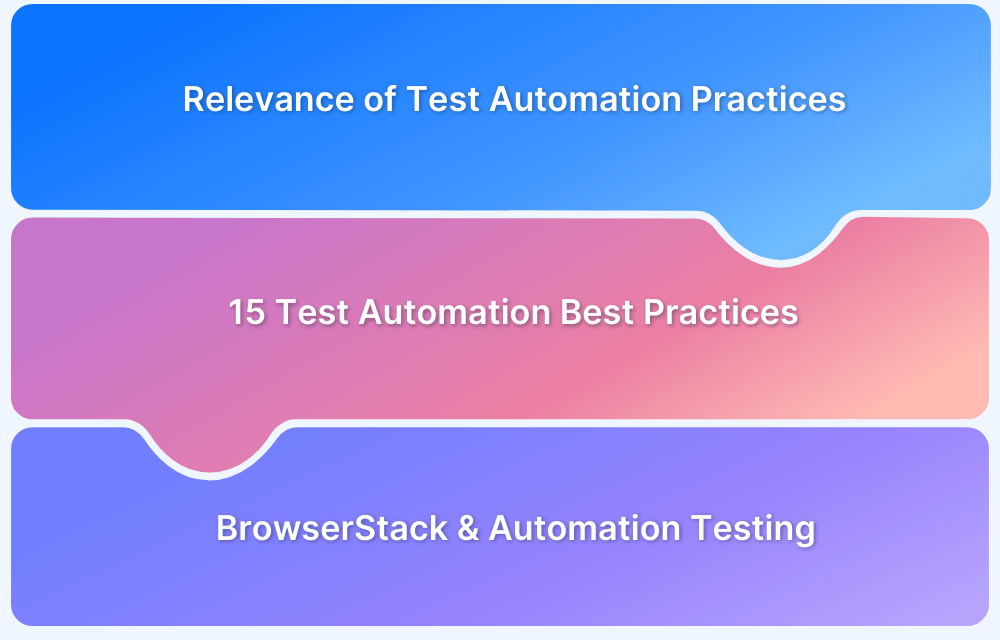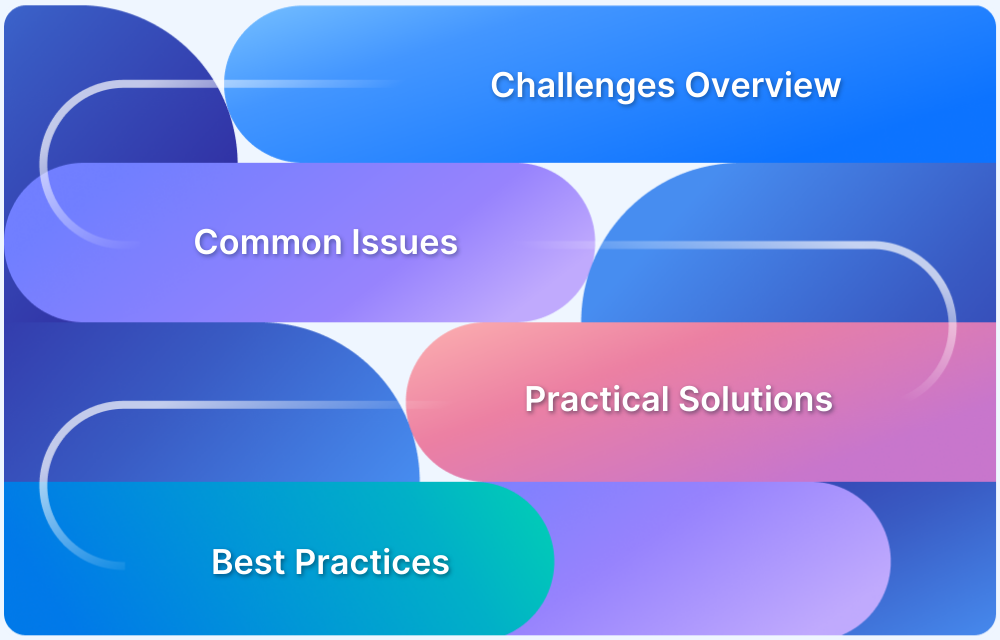Software testing ensures an application meets required standards by identifying bugs, ensuring functionality, and verifying performance.
Rapid technological advancements and Agile methodologies require software to evolve quickly, presenting challenges for QA teams to maintain thorough testing within shorter cycles.
This article highlights key software testing challenges and offers practical solutions to help teams navigate this fast-paced, competitive landscape.
Key Software Testing Challenges and Solutions
Here are some common software testing challenges teams often face and practical solutions to overcome them. Addressing these challenges ensures more efficient testing processes and higher-quality software.
Key Software Testing Challenges
- Lack of Communication
- Missing Documentation
- Diversity in Testing Environments
- Inadequate Testing
- Identifying the Right Automation Tool or Framework
- Employing Skilled Testers or Training Existing Teams
- Deciding on Test Automation Strategies
- Setting Realistic Expectations
- Initial Investment of Capital
- Instituting New Modes of Collaboration and Communication
- Flaky Test Scripts
- Test Data Management in Automation
- Integration with CI/CD Pipelines
- Scalability of Test Automation
- Lack of Test Coverage
- Handling Frequent Application Changes
- Regression Testing Overhead
- Performance Testing Challenges
Below is a description of each of these challenges and how you can solve them.
1. Lack of Communication
Communication gaps, particularly around software requirements, can prevent creation of accurate test cases. Issues like time zone differences, misinterpretations, and varying work shifts contribute to this.
To create effective test cases, testers need a clear understanding of both technical and business requirements, including user journeys and expected outcomes. Without this clarity, testing fails to be comprehensive.
Solution:
Regular collaboration between development and testing teams, with input from product managers, ensures alignment. BrowserStack Test Management enhances transparency and collaboration, boosting productivity.
2. Missing Documentation
In some cases, teams miss out on documenting the scope (functional and nonfunctional) and specific requirements of the project after interacting verbally with clients. This may lead to both developers and testers missing out on important aspects of what the client expects. They may need to proceed based on their assumptions, which will cause delays due to the running of unnecessary tests. This may also result in the development and testing of an unwanted feature.
Inadequate documentation leads to lower accuracy when it comes to requirement gathering. It is easy to miss out on vital information that has been conveyed only verbally.
Solution:
In order to avoid missing out on critical requirements and project objectives, teams must create comprehensive documentation with specific project requirements in detail. Complete documentation will serve as a baseline for QA teams throughout the project lifecycle. It will also help QAs understand expected product outcomes and build the most relevant tests.
3. Diversity in Testing Environments
Apps are accessed on thousands of devices, browsers, and OS combinations. Testing on every device is difficult due to the large number of devices and frequent new releases.
While emulators and simulators help in the early stages, they can’t replicate real-world performance. Bugs often only surface when testing on real devices. Establishing on-premise device labs is costly and impractical for many businesses.
Solution:
Testing platforms like BrowserStack provide on-demand access to 3,500+ real devices and browsers for testing apps and websites.
It eliminates the need for on-premise devices, offering seamless manual and automated testing in real user conditions. Integrating popular automation tools allows teams to test across diverse combinations efficiently.
Must Read: Test Environment: A Beginner’s Guide
Try our Real Device Cloud for Free
4. Inadequate Testing
Thorough testing is essential for ensuring robust applications, especially for complex software that requires extensive regression testing. However, tight timelines pressure teams to rush, often leading to missed test cases and insufficient coverage, allowing bugs to slip through.
Solution:
Prioritize and plan test cases based on importance and impact. Automate repetitive tests where possible and focus manual testing on critical areas.
Balancing automation and manual testing ensures comprehensive coverage while saving time. Prioritization will help QA teams focus on key areas early, ensuring quality and timely delivery.
5. Identifying the Right Automation Tool or Framework
With numerous automation tools available, selecting the right one that aligns with the project’s technology stack, budget, and testing needs can be daunting. An incorrect choice can lead to inefficiencies and wasted resources.
Solution:
Evaluate tools based on your application type, supported languages, ease of integration, and scalability. Popular options include Selenium for web testing, Appium for mobile testing, and Playwright for cross-browser automation.
6. Employing Skilled Testers or Training Existing Teams
Test automation demands expertise in scripting, framework setup, and debugging. Teams lacking skilled automation engineers often struggle with implementation and maintenance.
Solution:
Invest in upskilling your team through training programs, certifications (e.g., ISTQB Advanced Level), and workshops. If time-sensitive, consider hiring experienced automation testers to mentor existing staff.
Must Read: Test Case Vs Test Script
7. Deciding on Test Automation Strategies
Determining what to automate, how much to automate, and the sequence in which to automate can be challenging, especially for large applications.
Solution:
Adopt a strategy based on the testing pyramid: automate unit tests first, followed by integration test and UI tests. Prioritize repetitive, high-risk, and time-consuming test cases. Leverage risk-based testing to focus automation efforts on critical areas.
8. Setting Realistic Expectations
Unrealistic expectations about automation solving all testing problems can lead to disappointment. Teams may overlook the limitations of automation, such as the inability to replace exploratory or usability testing.
Solution:
Educate stakeholders on the scope and limitations of automation. Automation enhances efficiency but requires regular maintenance and cannot completely replace manual testing.
9. Initial Investment of Capital
Setting up an automation framework, purchasing tools, and training teams require significant upfront investment, which may not yield immediate ROI.
Solution:
Start small with open-source tools like Selenium or Cypress to reduce costs. Gradually scale the automation effort by automating high-priority test cases first. Measure ROI through metrics such as time saved and defect detection rate.
10. Instituting New Modes of Collaboration and Communication
Automation often demands tighter collaboration between developers, testers, and other stakeholders. Miscommunication or lack of alignment can delay progress.
Solution:
Adopt DevOps practices and use collaboration tools like Slack or Microsoft Teams to maintain transparency. Conduct regular meetings to ensure alignment between development and testing teams. Use version control systems like Git to track and share automation scripts effectively.
11. Flaky Test Scripts
Automated tests may fail intermittently due to dynamic UI elements, timing issues, or environmental instability. These flaky tests undermine trust in the automation suite.
Solution:
Implement robust synchronization methods like explicit waits or retries to handle timing issues. Use stable locators (Like, IDs or data attributes) for dynamic elements. Regularly review and debug flaky tests to maintain reliability.
Also Read: How to find Flaky Selenium Test Suite
12. Test Data Management in Automation
Automated tests often require consistent and reusable test data. Managing large datasets or creating data dynamically for every test can be cumbersome.
Solution:
Use test data management tools to create and store reusable datasets. Incorporate scripts to dynamically generate or clean up test data as part of your automation process. Maintain separate test environments to avoid data conflicts.
13. Integration with CI/CD Pipelines
Incorporating automated tests into CI/CD pipelines requires proper setup, resource allocation, and seamless integration, which can be complex.
Solution:
Use tools like Jenkins, GitHub Actions, or Azure DevOps to integrate automated tests into the pipeline. Schedule smoke test and regression tests during each build and deployment phase to catch issues early.
Learn More: How to Build an Azure CI/CD Pipeline?
14. Scalability of Test Automation
The automation suite can become unwieldy as applications grow, leading to longer execution times and increased maintenance overhead.
Solution:
Adopt parallel testing by leveraging cloud-based platforms like BrowserStack to execute tests simultaneously across multiple environments. Optimize scripts for modularity and reusability to simplify maintenance.
15. Lack of Test Coverage
Automation efforts may focus on easy-to-automate test cases, leaving critical or complex scenarios untested. This can result in inadequate test coverage.
Solution:
Use code coverage tools to identify gaps in your test suite. Focus on automating high-priority, high-risk test cases, including edge cases. Combine manual and automated efforts for comprehensive coverage.
16. Handling Frequent Application Changes
Frequent updates to the application, such as UI redesigns or feature enhancements, can lead to broken test scripts, requiring frequent updates.
Solution:
Adopt a modular testing approach to minimize script dependencies. Use design patterns like the Page Object Model (POM) to isolate UI changes and reduce script maintenance.
Useful Resources for POM:
- Page Object Model and Page Factory in Selenium
- What is Cypress Page Object Model?
- Page Object Model with Playwright: Tutorial
- Page Object Model in Selenium and JavaScript
- Page Object Model and Page Factory in Selenium C#
- Page Object Model and Page Factory in Selenium Python
17. Regression Testing Overhead
As applications grow, the regression test suite becomes larger and more time-consuming, slowing down release cycles and increasing the testing burden.
Learn More: Automated Regression Testing: A Detailed Guide
Solution:
Prioritize regression test cases based on recent changes and business impact. Automate tests using tools like Playwright or Cypress to save time. BrowserStack Test Management helps efficiently manage and prioritize test cases at scale, streamlining the process.
Read More: What is Test Case Prioritization?
18. Performance Testing Challenges
Applications must handle heavy user loads without performance degradation. Identifying bottlenecks requires simulating real-world traffic, which can be complex.
Solution:
Leverage performance testing tools to simulate user traffic and assess system behavior under load. Regularly conduct load, stress, and scalability tests throughout development to ensure optimal performance under varying conditions.
Conclusion
Software testing is an intricate and evolving process that presents several challenges, including cross-browser compatibility, device fragmentation, and the need for real-time collaboration. Ensuring applications perform seamlessly across different environments requires significant time, resources, and expertise.
Tools like BrowserStack offer a comprehensive solution to these challenges by providing an extensive cloud-based platform for testing websites and mobile apps across a wide range of browsers, devices, and operating systems. This eliminates the need for maintaining physical device labs and reduces testing time, enabling teams to focus on delivering high-quality, bug-free applications.
By offering real-time, automated, and manual testing capabilities, BrowserStack empowers developers and QA teams to streamline their testing processes and ensure consistent, flawless user experiences.
Frequently Asked Questions
1. What are the common challenges in manual software testing?
Common challenges in manual testing include:
- Time-Consuming: Manual testing takes longer, especially for repetitive tests.
- Human Error: Testers may miss defects due to oversight or fatigue.
- Limited Coverage: It’s hard to test all scenarios manually.
- Scalability: As software grows, manual testing becomes harder to scale.
- Inconsistency: Results may vary depending on the tester.
2. How can testing challenges be overcome in agile projects?
To overcome testing challenges in Agile:
- Use Continuous Integration (CI): Run tests continuously during each sprint.
- Adopt Test-Driven Development (TDD): Write tests before coding to align with requirements.
- Automate Repetitive Tests: Automate regression and functional tests for efficiency.
- Prioritize Critical Features: Focus testing on high-priority user stories.






